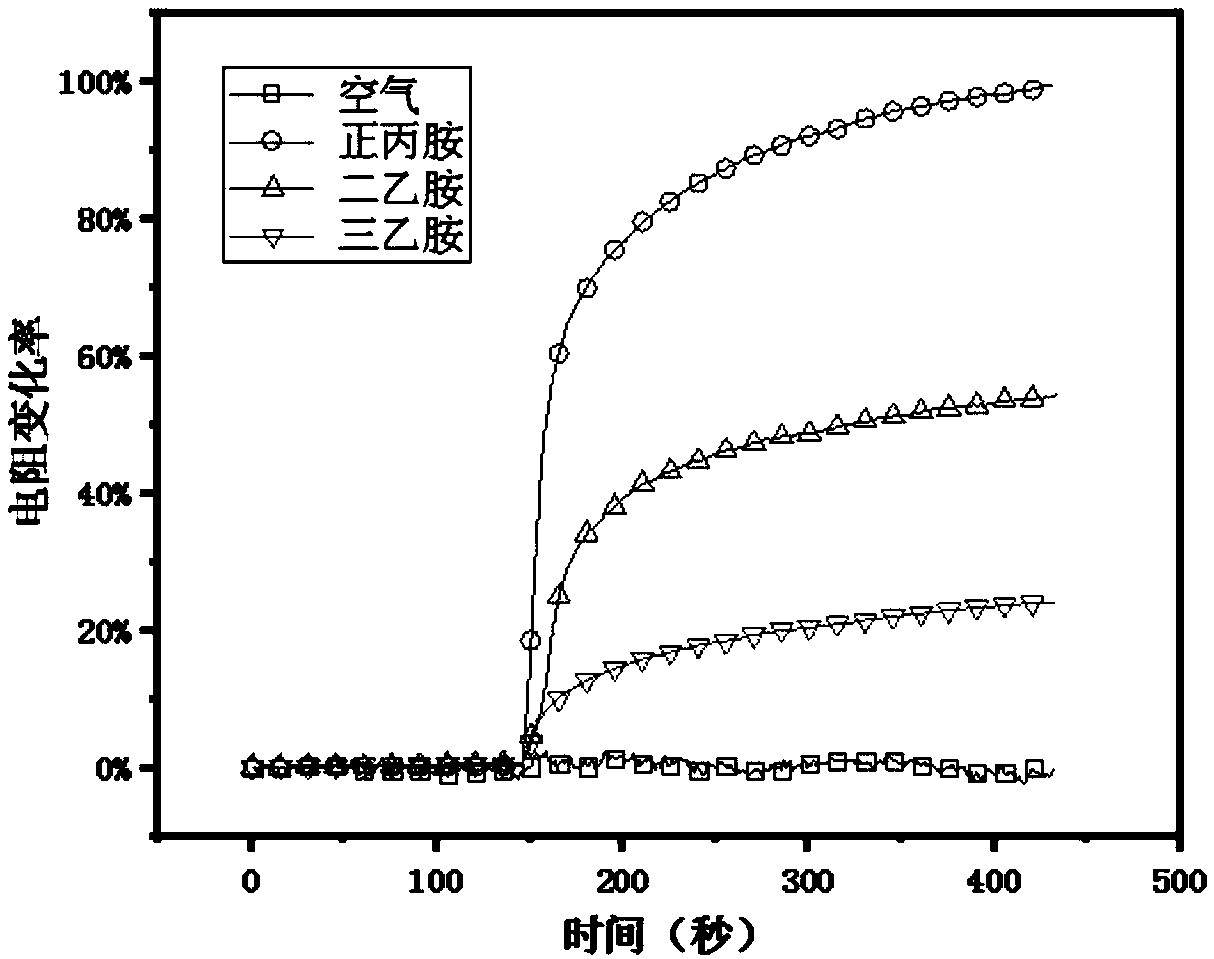Method for detecting organic amine volatile gas based on perylene-3, 4, 9, 10-tetracarboxylic dianhydride
A technology of perylenetetracarboxylic dianhydride and volatile gases, which is applied in the field of detection of volatile gases of organic amines, can solve the problems that the volatile gases of organic amines cannot be detected quickly, and achieve the purpose of improving the sensing performance of intensity regulation, enhancing sensitivity, Meet the effect of on-site measurement
- Summary
- Abstract
- Description
- Claims
- Application Information
AI Technical Summary
Problems solved by technology
Method used
Image
Examples
Embodiment 1
[0021] (1) Synthesis of sensing compound 3
[0022] Take 400mg3,4,9,10-perylenetetracarboxylic dianhydride (compound 1) and 1g octylamine (compound 2) and dissolve in 50ml methanol solution. Reflux for 5 hours and cool to room temperature. The reaction solution was acidified with 20 ml of saturated hydrochloric acid and stirred overnight. The product was suction filtered with a 0.45 μm filter membrane. The resulting solid was washed with methanol and deionized to neutral, and dried at 60°C to obtain the amide product (compound 3,9-octyl-1H-isochromeno[6',5',4':10,5,6]anthra[ 2,1,9-def]isoquinoline-1,3,8,10(9H)-tetraon), its chemical formula is as follows:
[0023]
[0024] (2) Preparation of sensing materials
[0025] Add 10 groups of 1mg single-walled carbon nanotubes into 15ml tetrahydrofuran, sonicate for 30min to disperse the single-walled carbon nanotubes in tetrahydrofuran; add 9mg of compound 3 to the THF solution of single-walled carbon nanotubes, and sonicate f...
Embodiment 2
[0033] (1) Synthesis of sensing compound 5
[0034] Mix KOH (50% aq, 40ml), TBAB (0.40g), 1,6-dibromofluorene (compound 4) 2.00g, stir at room temperature for 25min, wash with 100ml of water after the reaction, CHCl 2 Extraction (20ml×3). The organic phase was washed with 1M HCl, then with water, anhydrous MgSO 4 Dry, remove the solvent, and separate by column chromatography to obtain a pale yellow solid. Add 1.6 g of product to 0.33 g NaN 3 10ml of DMSO solution was stirred at 60°C for 2h. After the reaction, wash with water, extract with ether, wash the organic phase with water, anhydrous MgSO 4 After drying, the solvent was removed, and column chromatography separated to obtain a pale yellow oily liquid. The product (2mmol) was added to a solution of triphenylphosphinepalladium (1.572g, 6mmol) in THF and water (21ml / 3ml) and stirred at room temperature for 12 hours. Product (100mg, 0.19mmol) was added Zn(CH 3 COO) 2 (1mg, 2%) was put into a 50mL reaction flask, 5ml ...
Embodiment 3
[0039](1) Synthesis of sensing compound 7
[0040] A stirred mixture of 3,4,9,10-perylenetetracarboxylic dianhydride (5g, 12.7mmol, compound 1), chlorosulfonic acid (57.2g, 0.5mol) and iodine (0.9g, 3.45mmol) was heated to 60- 70°C, stirring for 20 hours. At room temperature, the mixture was treated with ice water. The solid was filtered, washed with ice water and dried in vacuo. The product (3.3g, 6.27mmol), n-octylamine (3.2g, 13.28mmol, compound 2) was mixed with 25ml of NMP (N-methylpyrrolidone), and the suspension was heated to reflux at 110°C for 24h, cooled to room temperature, and separated by filtration The resulting compound was obtained as a dark red crystalline product, which was washed with methanol, acetic acid and methanol respectively, and finally washed with ether, and dried in vacuum at 50°C for 24h. The above product (0.72mmol, 541.8mg) and 3,5-difluorophenol (6.75mmol, 878.1mg, compound 6) and potassium carbonate (7.25mmol, 1g) were added to 20ml N-methy...
PUM
 Login to View More
Login to View More Abstract
Description
Claims
Application Information
 Login to View More
Login to View More - R&D Engineer
- R&D Manager
- IP Professional
- Industry Leading Data Capabilities
- Powerful AI technology
- Patent DNA Extraction
Browse by: Latest US Patents, China's latest patents, Technical Efficacy Thesaurus, Application Domain, Technology Topic, Popular Technical Reports.
© 2024 PatSnap. All rights reserved.Legal|Privacy policy|Modern Slavery Act Transparency Statement|Sitemap|About US| Contact US: help@patsnap.com










